Cosmology in the 21st Century
Live-streamed from Perimeter Institute, & exclusive real-time commentary!
“Every generation of physicists solves some old puzzles and finds some new ones.” –Dr. Kendrick Smith
I want you to think back to — okay, imagine since you weren’t there — the beginning of the 20th century. As the 1800s gave way to the 1900s, there was talk of science coming to an end. Of the Universe being almost completely understood. After all, we had the laws of gravity and electromagnetism, the Sun, the stars and the Milky Way, the fundamental particles all the way down to the constituents of the atoms, and a whole host of nebulae, clusters and stellar remnants littering the heavens above.
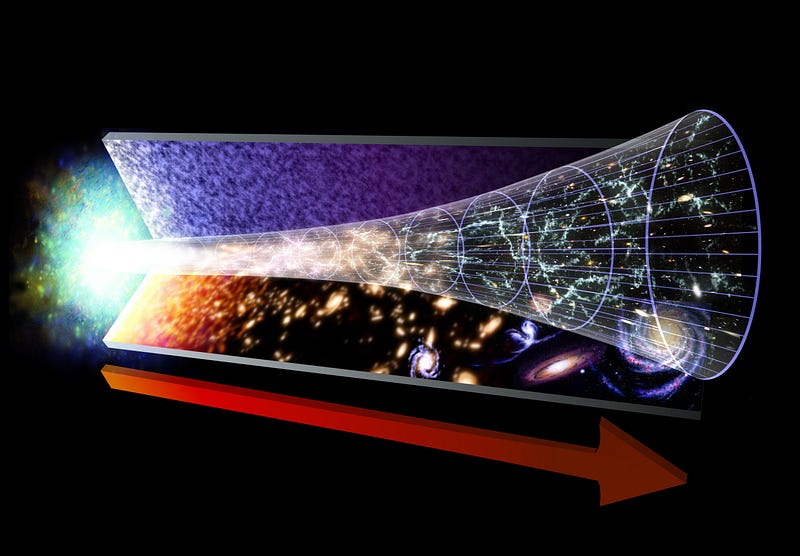
Little did we know that the 20th century would see us discover an entirely new theory of gravity, two more fundamental forces and dozens of new, fundamental particles, billions of galaxies beyond our own, and the origin of the Universe from a hot, dense expanding state.
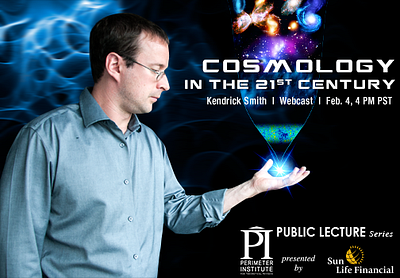
What’s more, is we also found some things we never could have anticipated: dark matter, dark energy, more matter-than-antimatter in the Universe, and an inflationary origin to our cosmos that preceded the Big Bang. On top of that, we have a whole host of open, unanswered questions that followed us into the present century: the 21st.
So where does that bring us today? To a spectacular event, happening February 4th at 7 PM Eastern / 4 PM Pacific time.
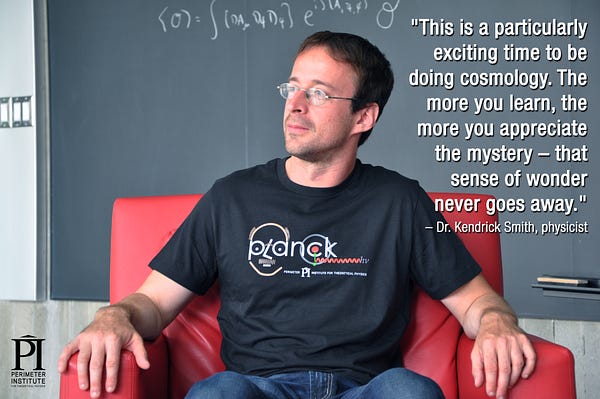
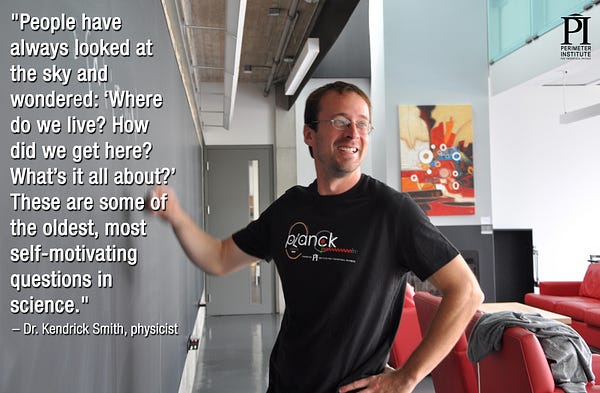
Perimeter Institute’s Kendrick Smith is set to deliver a public lecture on Cosmology in the 21st Century, and there are two special treats coming along with it:
- ) The lecture will be webcast live, and you can view it right here, below, no matter where in the world you are! And perhaps even more exciting…
- ) Below the video, I will be live-blogging original, expert-level astrophysics commentary and explainers on everything he talks about!
How do you do both? How do you watch/listen to the lecture and follow the live-blog commentary simultaneously?
(Update: The lecture is now permanently archived and viewable at the link below; you can follow along with my live-blog commentary; 0:00 on the video corresponds to the start of the talk at about 3:59 PST.)
Click “play” on the video above, and then open a duplicate of this page in another tab/window, which you should refresh every few minutes. I’ll be making updates continuously, and you do not want to miss this event! You can even leave real-time comments (in the sidebar) and I’ll try to get to them as soon as I see them.
Come be a part of this interactive experience, starting in less than 24 hours!
Live Blog
3:49 PST — Perimeter Institute’s pre-recorded footage has begun, showing pre-recorded footage from today’s speaker, Kendrick Smith. The video they’re showing right now, on the cosmic microwave background, is permanently live here:
3:53 PST — A pre-recorded message has Kendrick telling us that “dark matter” is a terrible name. He’s right, by the way. “Dark matter” implies that you have some type of matter that absorbs or otherwise restricts light, while dark matter is actually completely transparent to light. I would have named it something like “invisible matter” if I had my choice, but I suppose it’s better than the name that existed before, where they simply called it the missing mass problem.
3:58 PST — Hey! Overlords at Medium! Guess who got you a “Perimeter Institute thanks our partners” shout-out?
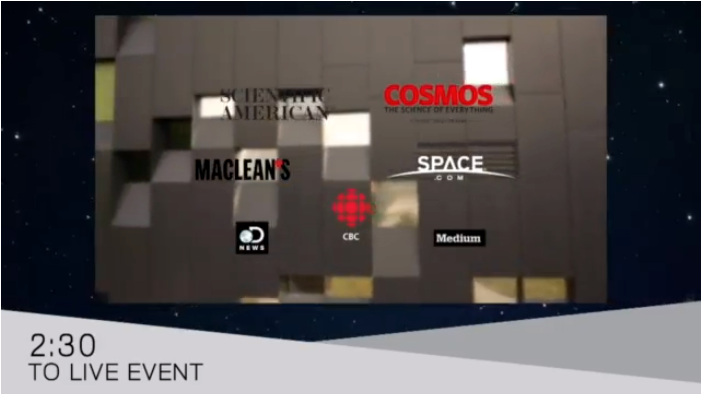
4:01 PST — Hooray for an on-time start!
4:03 PST — They announce that Dr. Smith has a background in computational and theoretical cosmology, with experience analyzing data from a number of missions. Note that this was one of the most alluring aspects of theoretical cosmology for me, my advisor and many others: in order to be good at it, you need to learn about a huge variety of different physics fields, from nuclear/particle physics to gravitation, data analysis techniques, and the interplay of theory with phenomena.
4:05 PST — And now the lack-of-slides is starting to become a problem. Come on, you guys can get it working! “Ah, great!” Followed by applause.
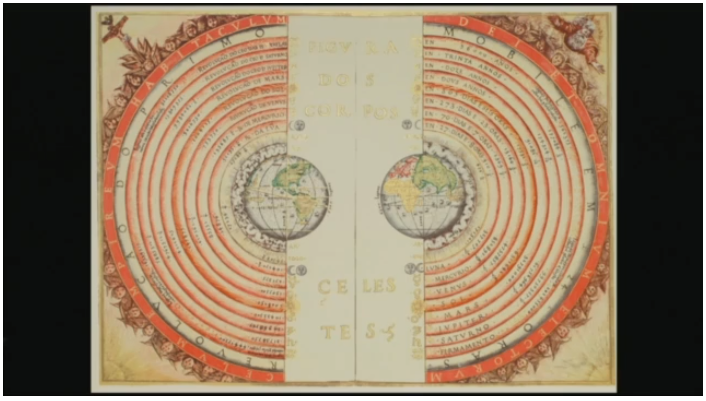
He starts with astronomy ~1000 years ago; this is pretty accurate for what we thought. Ironic how our picture of the Universe in ~170 C.E. (Ptolemy’s time) was identical to our picture in ~1500 C.E.
4:07 PST — Kind of amazing, he states (correctly), that the biggest questions that concerned our existence for all of human history:
- How did our Universe begin?
- What is it made of?
- How will it end?
Are all now known. This talk promises to go into it.
4:09 PST — The start of our modern picture of the Universe? Hubble. (The man, not the telescope.)
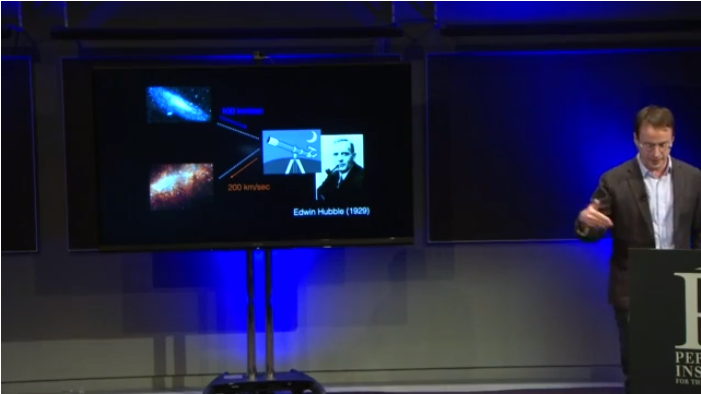
Why’s that? Because you can tell how quickly a galaxy is moving along the line-of-sight to us simply by measuring how its light is shifted: either towards the red or the blue. The fact that redshift increased with distance is what led to the picture of the expanding Universe, confirming the “unacceptable” prediction (at least, according to Einstein) of General Relativity.
4:12 PST — A huge point: distances between two galaxies in an expanding Universe are not fixed! You think of distances as something that you measure with a ruler, which is always the same. But in an expanding Universe, which basically means anything that isn’t bound together by the gravitational, electromagnetic or nuclear forces, the distances between any two objects grow over time.
4:15 PST — An important point: not all galaxies expand uniformly. Consider what we actually see when we look out in the Universe, at real galaxies.
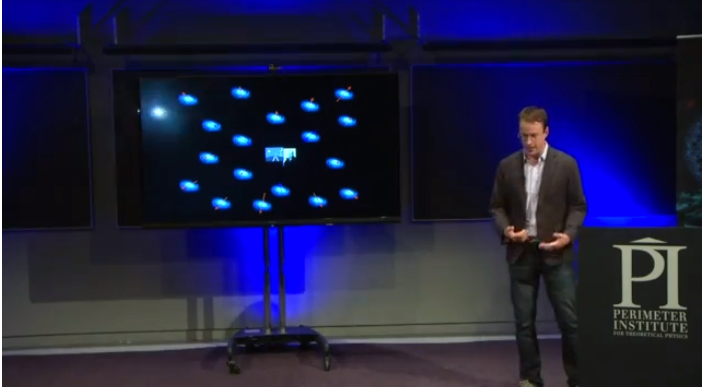
Some galaxies are clumped together in pairs, groups or even larger clusters, and their gravitation influences one another. This “extra” motion on top of the Hubble expansion is known as peculiar velocity, and can be as large as a few thousand km/s. That’s why it’s so important, to measure the expansion rate, to get a huge number of galaxies out to great distances.
4:18 PST — We live at a special time in the Universe: late enough so that things are not too hot and dense, but early enough that our Universe is still filled with stars and galaxies. Note that this isn’t that special: things were only “too hot and dense” for the first few million years, back when there weren’t enough heavy elements to have interesting chemistry, and things will only be sparse and empty after hundreds of billions of years, or tens of times the present age of the Universe.
4:20 PST — He is illustrating how a cloud of gas collapses into a galaxy. Here’s a great simulation that’s actually more illustrative than the one he chose by the same (University of Washington) group:
4:22 PST — For those of you looking at the scale of his large-scale simulation, things are given in terms of “kpc” or “Mpc” which stand for either kiloparsecs or Megaparsecs. A parsec is about 3.26 light-years, and the Milky Way galaxy is about 30 kpc in diameter, for scale.
4:25 PST — If you run the clock of the Universe backwards, you get a plasma instead of neutral atoms.
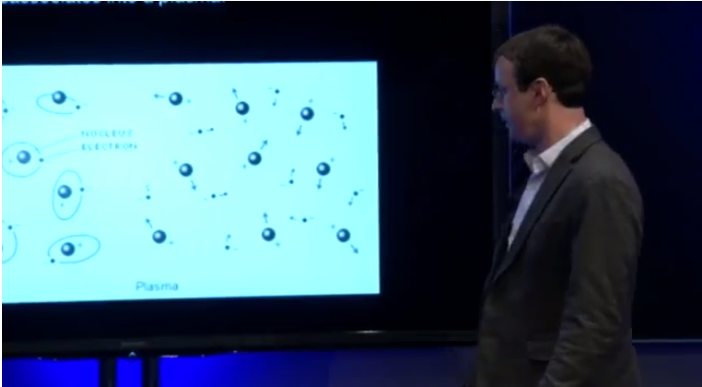
Eventually, going backwards to hotter temperatures, greater densities and earlier times, you expect it to be so hot that neutral atoms couldn’t have formed. Matter normally exists in three states: solid, liquid and gas, but there is a fourth state that occurs when electrons become unbound from their nuclei: plasma.
When the Universe finally cools from a hot, dense state enough so that neutral atoms can form, you finally become transparent to radiation/light, which means you can see the leftover glow emanating from that surface-of-last-scattering. That is what the Cosmic Microwave Background — discovered 1965 by Penzias and Wilson — is.
4:29 PST — An interesting picture of the Universe: as we look out in space, we also look back in time, meaning that we have an interesting viewpoint where we are.
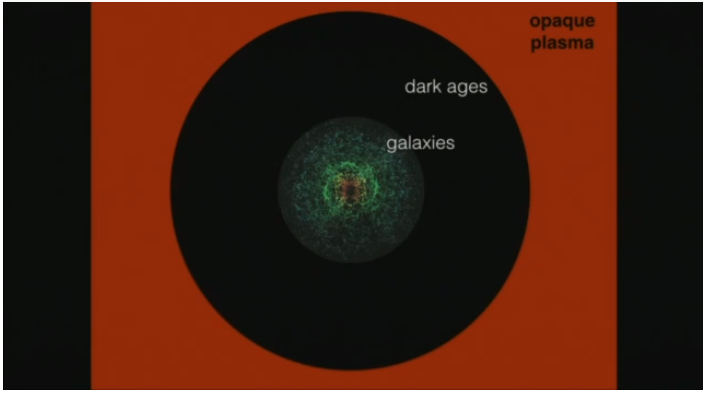
We have galaxies clustered near to us, but early on, there were no stars to light up the skies. Even before that, there’s the transition region between plasma-and-gas, and we can see the leftover radiation from that moment as (today) the cosmic microwave background. Note (as he describes) that all observers would see this picture; we’re not the center, rather, we see what all observers see.
4:31 PST — Important point: he says the Universe looks finite. One point he misses that I think is very important is that it appears finite to us only because it has been around a finite amount of time, and so we can only see a finite amount of it. (You know, that whole space-and-time thing.)
4:33 PST — He shows a cool video of how the Planck satellite works. Here’s the permanent link to it:
4:36 PST — Interesting point here: he shows the fluctuations in the cosmic microwave background as imaged by WMAP:
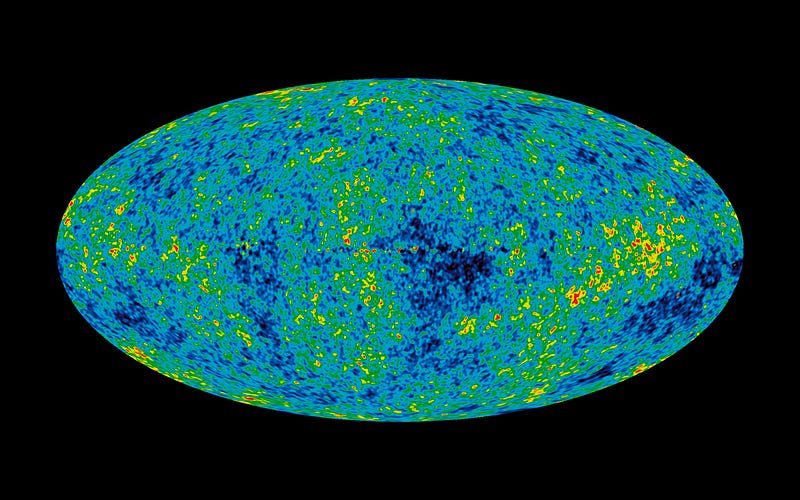
And then talks about how the “cold spots” which are the overdensities grow, gravitationally, into clumps that form stars, and then clump together into galaxies on larger scales over time.
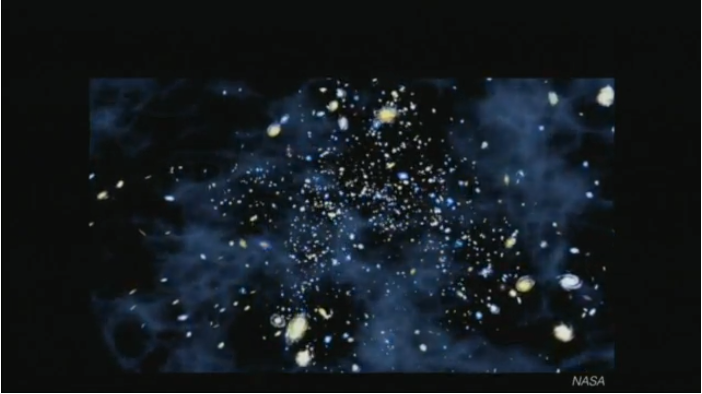
But I want to be clear: the fluctuations we see in the microwave background today are not the same fluctuations that cause the structure we see today! The fluctuations are “only” a few tens-to-hundreds-of-thousands of years in “depth”, so that if we were to look at the CMB again in 50,000 years or so, it would look entirely different in terms of where the hot-and-cold-spots are.
The structure we see in the Universe today is representative of where the fluctuations were billions of years ago; what we see today is not in any way responsible for the structure in our observable Universe.
4:39 PST — He tells us that the CMB tells us about the existence of dark matter and dark energy, which is true. But it is not the only thing telling us about the existence of those things. Even without the CMB, observations like:
- the clustering of galaxies on the largest scales,
- distant supernovae data,
- the abundance of the light elements,
- and gravitational lensing and X-ray data from active clusters,
all point towards the existence of dark matter and dark energy when taken together. If we had never observed the fluctuations in the CMB, we would still know these things (and their relative abundances) incredibly well.
4:42 PST — For example:
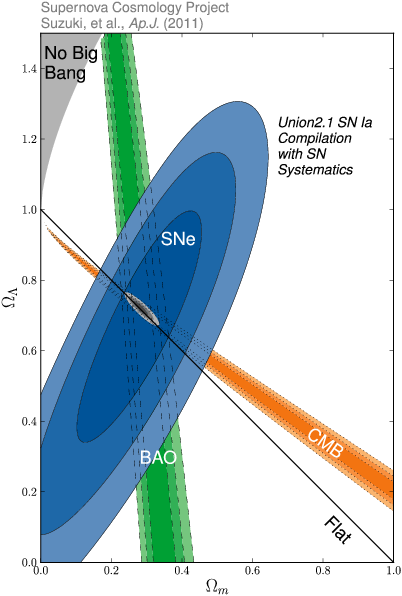
4:43 PST — In the midst of this, he mentioned there are three things (mysteries) that pretty much all cosmologists are studying. Here’s what they are:
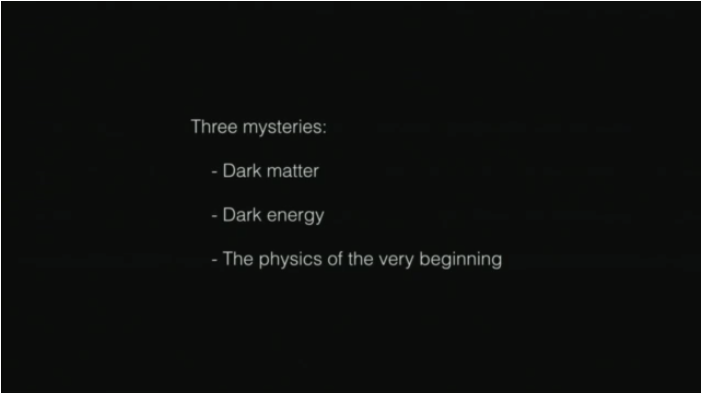
To be fair, these three things were the bulk of what I studied and researched, but this is also a very narrow view of cosmology. We are concerned with all of how the Universe came to be and came to be the way it is today. Dark matter and dark energy play a major role, but they are not the only important things, even if they make up some 95%+ of the Universe’s energy density.
4:47 PST — Some interesting possibilities surrounding dark energy. It might not be what we think it is; after all, it’s just a term to describe the accelerated expansion that we see for distant galaxies at late times.
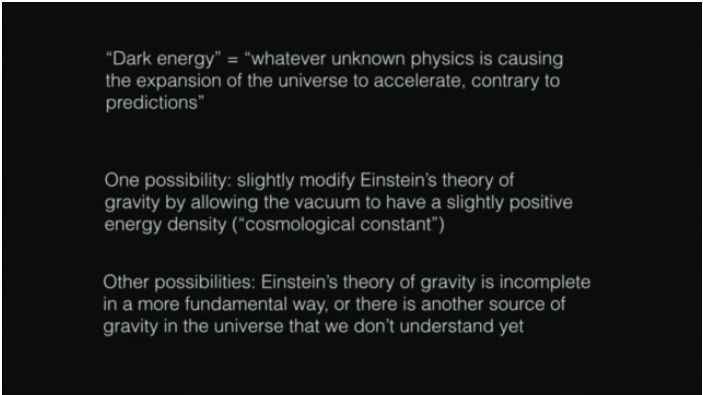
He also says that the “fate of the Universe,” dominated by dark energy of being a cold, lonely place, is a little depressing. Don’t worry, though; as long as you’re gravitationally bound to something — as our entire local group is — it’ll stick with us. We’ll be a little lonely, but we’ll still have trillions of stars and stellar remnants to keep us company.
4:52 PST — He’s presenting an interesting formulation of the horizon problem, which is how we say that distant regions of the Universe must have been in contact with one another — exchanging information — at some point in the past.
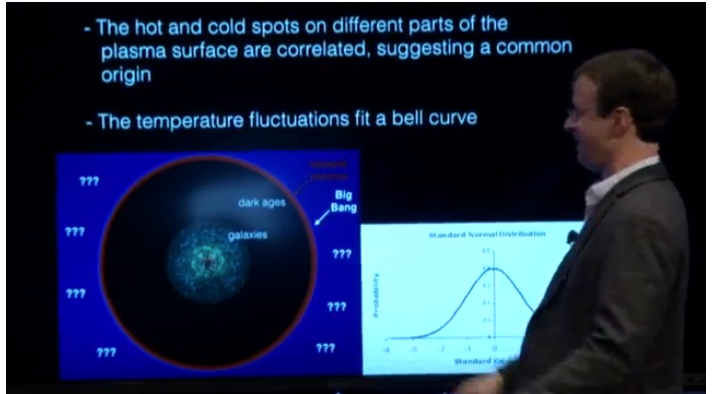
If we see a prevalence of “hot spots” in one region of the sky, we know that the rest of the sky has an excess of “cold spots.” This is observed to be true (illustrated by his bell curve on the right), and yet there’s no way that this information could exist in the Universe, unless something happened prior to the Big Bang to cause that contact to have occurred. This is an interesting (well-after-the-fact) motivation for the theory of inflation.
I say after-the-fact because Guth had the idea for inflation in 1979:

But we didn’t measure the spectrum of fluctuations in the CMB to any reasonable precision or degree of accuracy until COBE in the 1990s.
4:55 PST — He keeps talking about “1982” as the year of inflation. Well, it’s the year that “new inflation” came along, but the idea of inflation was around before that. New inflation is just the first completely, 100% viable model of inflation that came along. Alan Guth proposed-and-published “old inflation” in 1980/1981, Andrei Linde and the team of Andy Albrecht and Paul Steinhardt (independently) proposed “new inflation” in 1982/3, and Linde came up with another solution — chaotic inflation — in 1986. Since then, many other variants have been found to exist, but they all share the same generic features, with only minor differences to be found in their details.
4:58 PST — A moment of levity: a true-to-life map of Canada!

5:00 PST — Why map out the dark ages? Because there’s a lot more volume of space, and a lot more information, contained in that region of the Universe than just at the “surface” of last scattering.
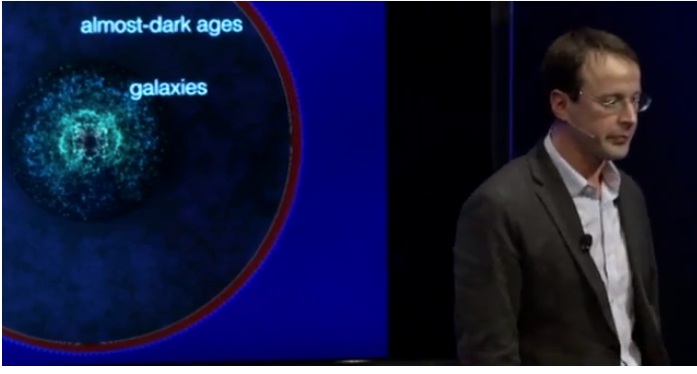
Hence we can learn an awful lot — some of which might be unexpected and might surprise us — about the Universe by studying it. More data = more knowledge for all!
5:03 PST — Impressively, despite the technical difficulties at the beginning, he finished on time! We are now in the Q&A phase.
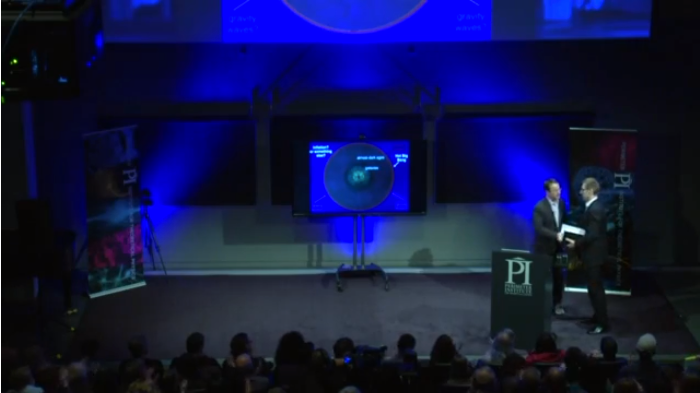
5:04 PST — When he says, “A transition from a quantum mechanical Universe to a plasma Universe,” he is neither implying that our Universe now doesn’t have quantum mechanics (it does) nor that “plasma cosmology” has any validity (it doesn’t), but he means that the Universe’s energy content was dominated by energy inherent to space itself (during inflation) and then transitioned to a state that was dominated by matter, radiation, antimatter, neutrinos and stuff, which is the transition occurred at the moment of the Hot Big Bang.
5:07 PST — Question: just like we have “WIMPs,” is there speculation as to the nature of dark energy?
The answer he won’t give: yes, and that’s all we have, speculation. We have a measured (phenomenological) equation-of-state to dark energy, and constraints on possible deviations from the cosmological constant explanation, but nothing compelling at all.
5:09 PST — Final question: how will the Universe end?
He gives the dark energy answer, and talks about the dimming of the CMB, and assumes the decay of matter. You can get a few more details here.
5:11 PST — Sike! Bonus question: philosophically, when can we say we’ve arrived in the Universe? I actually like his answer: we can never say, we just have to keep on exploring.
And that’s the end of the live-blog and the webcast!
Leave your comments — in advance or when it’s over — at our forum here!





